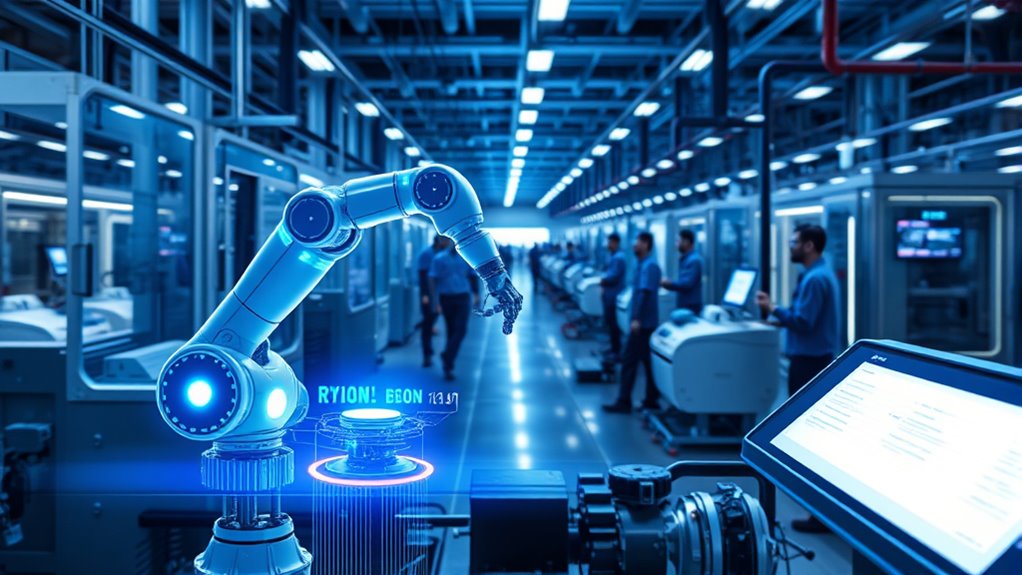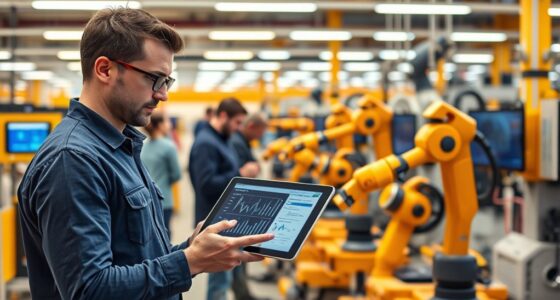Digital twins are transforming manufacturing by changing how you work, learn, and adapt. They provide real-time insights, enable virtual testing, and support predictive maintenance, which requires new skills like data analysis, digital literacy, and system diagnostics. This shift promotes smarter decision-making and remote collaboration, including hybrid work environments. If you want to discover how to stay ahead in this evolving landscape and develop the right competencies, there’s more to explore ahead.
Key Takeaways
- Digital twins transform workforce roles from manual oversight to managing virtual models and data-driven decision-making.
- Skills in digital literacy, data analysis, and cybersecurity become essential for operating advanced manufacturing systems.
- Workforce training leverages immersive, scenario-based platforms to accelerate learning and enhance emergency preparedness.
- Automation of routine tasks allows workers to focus on higher-value activities, fostering continuous skill development.
- The evolving manufacturing landscape emphasizes remote monitoring and collaboration, supported by digital twins and flexible workspace designs.
Transforming Manufacturing Operations With Digital Twins

Digital twins are revolutionizing manufacturing operations by providing real-time insights and virtual models of physical assets. They analyze data continuously, helping you optimize production processes, allocate resources more efficiently, and cut costs. With predictive maintenance, digital twins forecast equipment failures, so you can perform timely repairs and reduce downtime. They also enable virtual testing of new product designs, speeding up development and ensuring better quality before physical production begins. By integrating data from various sources, digital twins foster collaboration across teams, leading to smarter decision-making. Live monitoring of equipment performance detects anomalies early, preventing costly breakdowns. Additionally, simulation capabilities allow you to test different scenarios without disrupting operations, ultimately improving efficiency, reducing expenses, and supporting continuous innovation. Real-time data processing further enhances their ability to provide immediate insights for better operational control. Incorporating advanced manufacturing techniques such as digital twin technology can also optimize customization and flexibility in production lines.
The Role of Artificial Intelligence in Enhancing Digital Twin Capabilities
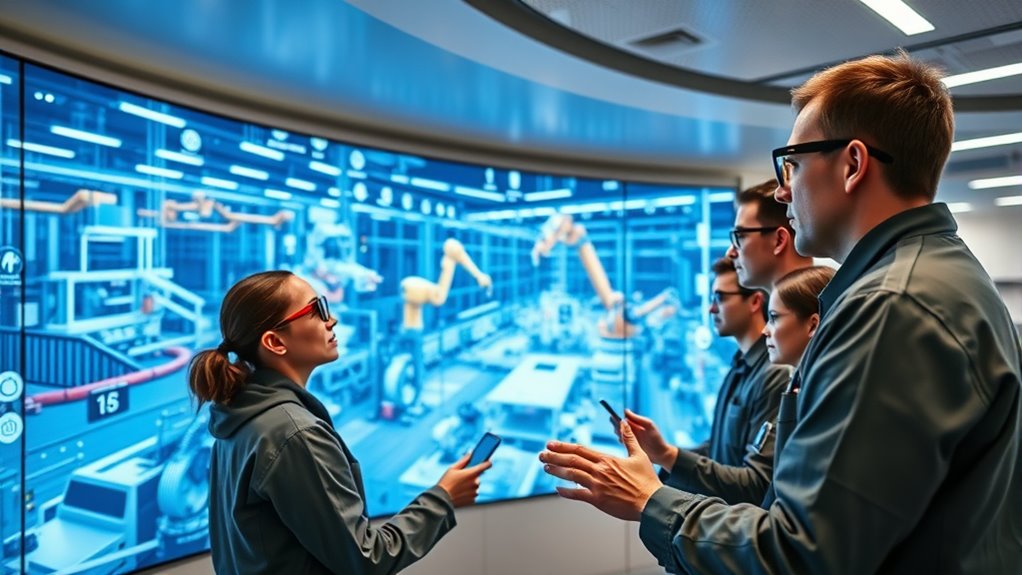
Artificial intelligence amplifies your digital twin capabilities by providing deep data insights and real-time analysis. It enables predictive maintenance, helping you prevent failures before they happen, and supports generative design to optimize product development. By integrating AI, you transform your manufacturing processes into more efficient, innovative systems. Furthermore, digital twins combined with AI support process optimization by enabling detailed scenario simulations that prepare for potential disruptions and improve resource allocation. Incorporating contrast ratio considerations into digital models can further enhance visualization accuracy and decision-making precision.
AI-Driven Data Insights
AI plays a crucial role in transforming how digital twins deliver actionable insights, enabling manufacturers to optimize processes, improve quality, and boost sustainability. With AI-driven data insights, you can virtually test production workflows, identify bottlenecks early, and adapt swiftly to changing demands. This technology empowers you to make smarter decisions and reduce waste. Digital twins utilize AI to continuously learn from new data, further enhancing their predictive capabilities. Here are three ways AI enhances digital twin capabilities: 1. Effortlessly pinpoint inefficiencies and optimize resource allocation for maximum productivity. 2. Detect quality deviations early, preventing defects before they reach customers. 3. Simulate energy use and sustainability scenarios to minimize environmental impact. Additionally, integrating real-time data collection ensures the digital twin remains up-to-date, providing more accurate insights for ongoing improvements.
Predictive Maintenance Power
Have you ever wondered how manufacturers prevent costly equipment failures before they happen? AI-powered real-time monitoring and anomaly detection make this possible. By analyzing data from IoT sensors, AI continuously tracks equipment conditions, spotting subtle signs of wear or irregularities early. Digital twins visualize these insights dynamically, allowing immediate fault recognition. Edge computing speeds up response times by processing data on-site, reducing delays. This proactive approach profoundly cuts unplanned downtime—studies show up to 70% fewer failures. Deep learning models diagnose complex failure modes and predict degradation, enabling scheduled maintenance before breakdowns occur. Utilizes advanced machine learning algorithms and real-time data analytics, the result? Lower maintenance costs, longer machinery lifespan, and increased operational efficiency. AI’s predictive capabilities are transforming manufacturing, making equipment more reliable and production more sustainable.
Generative Design Capabilities
Building on the capabilities of digital twins in predictive maintenance and real-time monitoring, generative design harnesses advanced artificial intelligence to revolutionize manufacturing processes. It creates highly detailed and realistic representations of assets, enabling better simulation, optimization, and decision-making. With generative AI, you can explore numerous design options simultaneously, accelerating innovation and customization. This technology also refines digital twin models by simulating various production scenarios, helping you identify the most efficient configurations. The synergy multiplies value across design, operations, and production, opening new possibilities. Plus, you can experiment virtually with strategies before deploying them on the factory floor, reducing risks and costs. Incorporating material properties into digital twins further enhances the accuracy of simulations and predictions.
Evolving Skills and Competencies for the Digital Workforce
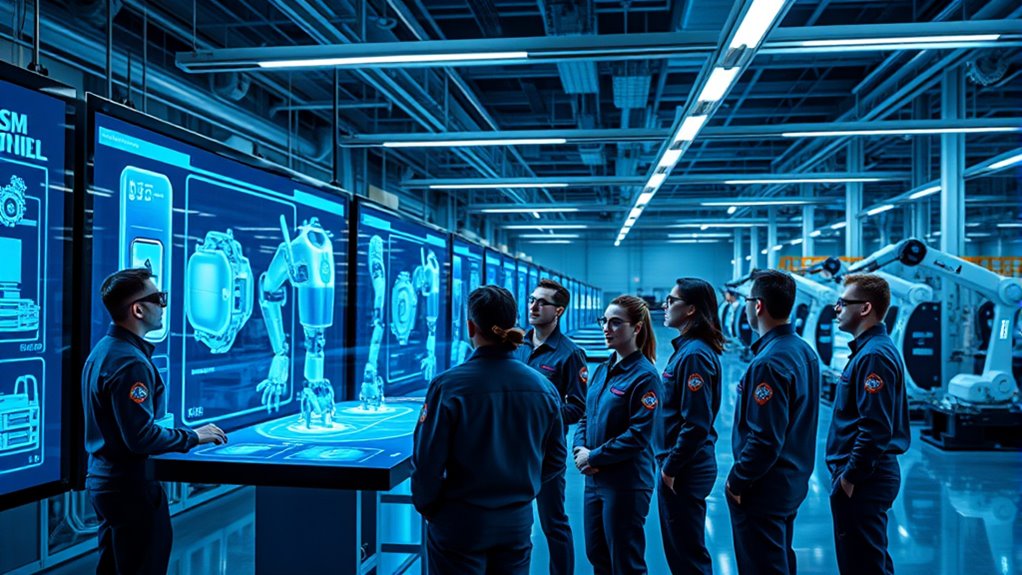
How can manufacturing organizations keep pace with rapid technological advancements? You must focus on developing your workforce’s evolving skills and competencies. Digital literacy is essential—training your team to interpret data from IoT devices enhances decision-making. Mastering AI, automation, and data analysis ensures your staff can operate and maintain advanced systems. Embrace continuous learning to stay current with emerging tools. Here’s a quick overview of key skills:
| Technical Skills | Soft & Process Skills |
|---|---|
| Cloud Computing & Cybersecurity | Adaptability & Problem-Solving |
| Industrial Robotics & Data Analysis | Collaboration & Innovation |
Additionally, fostering a dynamic communication environment within teams can significantly improve collaboration and problem-solving efficiency.
Impact of Digital Twin Technology on Traditional Manufacturing Roles

Digital twin technology is changing traditional manufacturing roles by automating routine tasks and shifting focus toward supervision and analysis. Instead of manual labor, you’ll find yourself interpreting real-time data and making strategic decisions supported by virtual models. This transformation requires new skills, blending technical expertise with problem-solving to keep operations running smoothly. Digital twins enable dynamic production scheduling and scenario analysis, which further emphasizes the need for workers to understand complex data systems rather than perform repetitive manual tasks. Additionally, understanding local laws related to manufacturing and employment can influence how companies implement these technologies and manage workforce transitions.
Shifts in Skill Requirements
As digital twin technology becomes more integrated into manufacturing, it fundamentally reshapes the skills required for traditional roles. You’ll need to shift from manual oversight to managing virtual models, making data literacy essential. Maintenance roles move from reactive fixes to predictive analytics, demanding familiarity with real-time system diagnostics. Quality assurance now involves blending digital feedback with physical inspections, requiring digital-physical integration skills. Supervisors leverage digital twins for scenario planning and rapid decisions, so proficiency in data visualization and simulation tools is critical. Digital twins range from visualizing equipment data to full production line simulations, so understanding how to interpret complex data sets becomes increasingly important. 1. Mastering IoT, sensors, and data analytics to interpret system outputs. 2. Developing expertise in simulation software and virtual modeling. 3. Learning to interact with AR/VR interfaces for training and operations. Gaining knowledge of best heat pump features and maintenance can also be valuable for integrating sustainable practices into manufacturing processes.
Automation of Tasks
The integration of digital twin technology is transforming manufacturing roles by automating many routine tasks and optimizing processes. You’ll see task automation in shop scheduling, where algorithms analyze real-time and historical data to streamline production sequences, reducing bottlenecks and cycle times by measurable margins. Automated virtual simulations enable dynamic schedule adjustments, minimizing human intervention. Predictive maintenance uses sensor data and AI to forecast equipment failures, shifting roles from reactive repairs to proactive planning, lowering downtime. Virtual commissioning automates factory setup and layout validation, cutting engineering rework and speeding up deployment. Real-time monitoring consolidates data, enabling automated process analysis and quick operational adjustments. These advancements reduce manual oversight, allowing your team to focus on higher-value activities while ensuring efficiency and responsiveness across manufacturing operations. Additionally, digital twins facilitate continuous learning and process improvement by analyzing operational data to refine workflows and optimize resource allocation over time. This ongoing optimization underscores the importance of adaptability and flexibility in modern manufacturing environments.
Embracing Hybrid Workspaces in Modern Manufacturing Environments
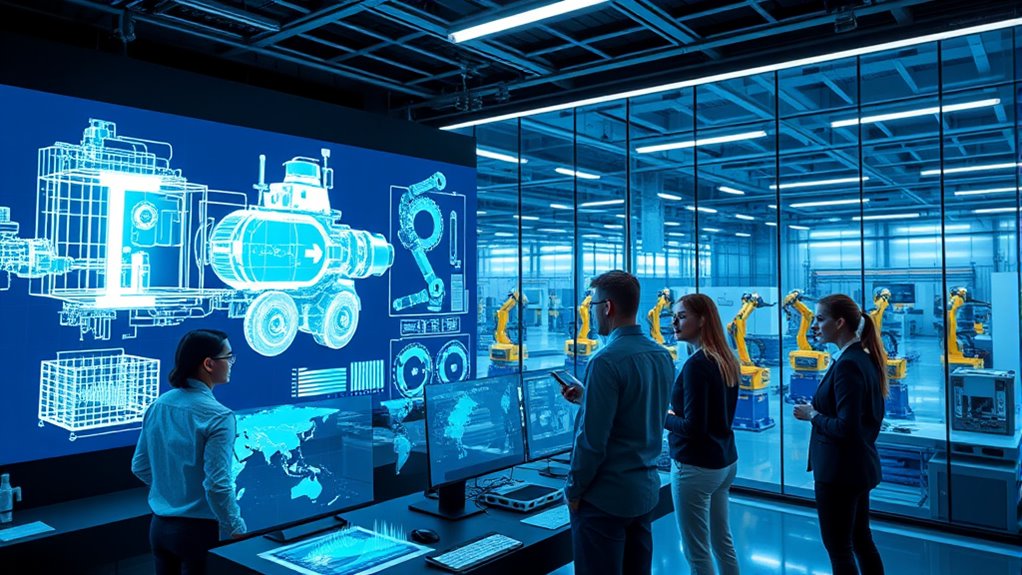
Embracing hybrid workspaces in modern manufacturing environments requires a strategic approach that leverages digital tools and flexible space design to accommodate diverse work styles. You can create a dynamic environment where remote collaboration and on-site tasks coexist seamlessly. Digital twins and IoT platforms enable real-time monitoring, troubleshooting, and teamwork from anywhere, boosting your operational agility. With smarter workspace analytics, you can optimize space and schedule effectively, ensuring your team’s needs are met. Incorporating glycolic acid products into skincare routines can also promote well-being and confidence among your workforce, supporting overall productivity and morale.
Strategies for Workforce Development in the Age of Digital Twins
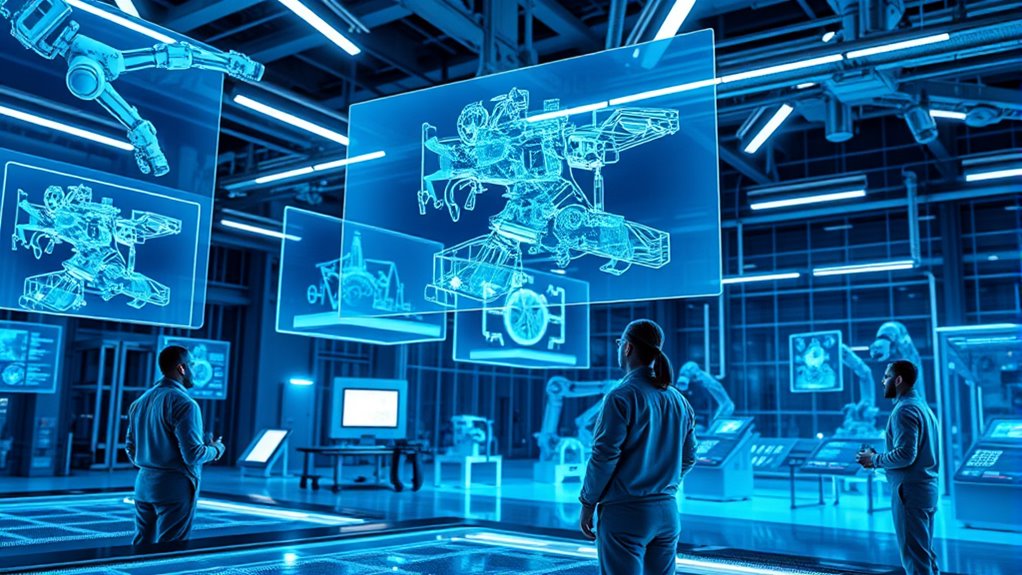
Integrating digital twins into workforce development transforms how you train and attract talent by creating immersive, interactive learning environments. These platforms enable hands-on training without physical risks, speeding up skill acquisition. They simulate complex and hazardous scenarios, helping workers develop problem-solving and emergency response skills safely. Digital twins standardize training across locations, ensuring consistent knowledge transfer and scalability. They provide real-time insights, deepening understanding of equipment and processes, while reducing cognitive load through data-backed decision support. To attract and retain talent, you can leverage digital tools to make manufacturing roles more engaging and technologically appealing. Automation of routine tasks frees workers for higher-value activities, aligning with the skills your workforce needs now and in the future. Research shows that digital twin technology is increasingly adopted across industries to enhance training efficiency and safety, which is a strategic move to stay competitive in a rapidly evolving manufacturing landscape. This strategic approach guarantees your team remains adaptable and competitive.
Future Trends and Opportunities for Manufacturing Professionals
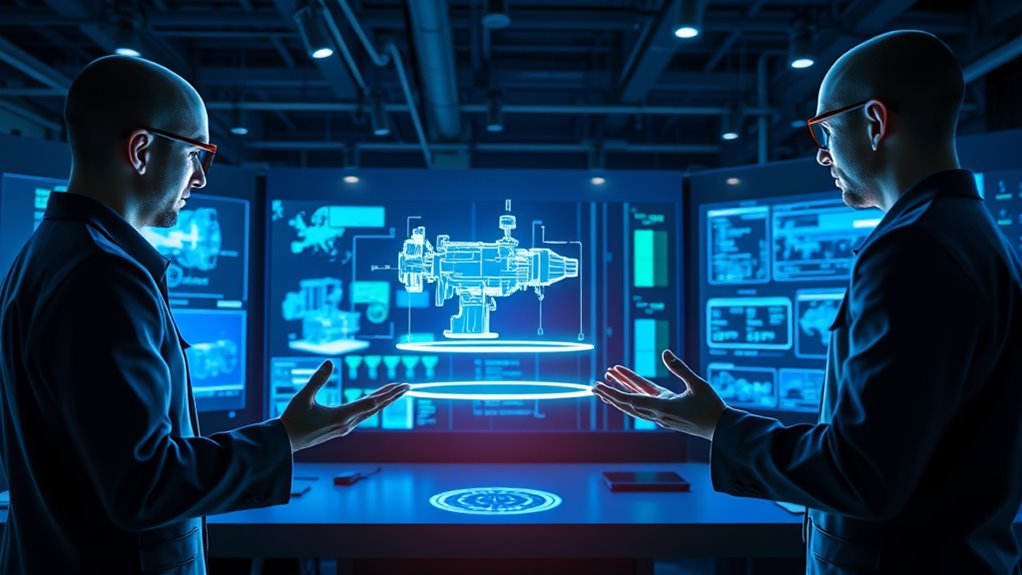
As digital twin technology advances, manufacturing professionals must stay ahead of emerging trends that shape the industry’s future. The integration of IoT and AI will revolutionize how you analyze data and predict outcomes, creating smarter, more efficient factories. Costs will decrease as digital twins optimize processes and identify bottlenecks, boosting your bottom line. Additionally, the rise of decentralized manufacturing offers incredible opportunities for agility, customization, and local talent development. Adoption of intelligent automation in manufacturing firms is accelerating, allowing for more seamless integration of digital twins into existing operations.
Here are three key trends to watch:
- Embrace increased IoT and AI integration to enhance decision-making and operational efficiency.
- Leverage decentralized models for greater responsiveness and market adaptability.
- Develop skills in digital literacy, data analysis, and cybersecurity to stay competitive in this evolving landscape.
Frequently Asked Questions
How Do Digital Twins Impact Manufacturing Safety Protocols?
You see, digital twins transform safety protocols by letting you virtually test and refine safety procedures before applying them physically. They provide real-time data and simulate various scenarios, helping you identify risks early. This proactive approach reduces incidents, improves risk assessments, and enhances training through immersive visuals. As a result, you create a safer environment, respond faster to hazards, and foster a stronger safety culture across your manufacturing operations.
What Are the Cybersecurity Concerns With Digital Twin Integration?
You should know that cybersecurity concerns are critical as digital twin adoption grows, projected to reach $138 billion by 2030. You face risks like network vulnerabilities from IoT and cloud connections, which can be exploited by hackers. Data manipulation and unauthorized access threaten system integrity. To combat these, you need strong access controls, real-time monitoring, and proactive security measures aligned with frameworks like NIST to safeguard your digital twin systems.
How Does Digital Twin Technology Influence Supply Chain Management?
Supply chain management becomes more efficient when you use digital twin technology. You get real-time visibility into operations, enabling you to make quick, informed decisions. It helps you predict disruptions, optimize workflows, and simulate different scenarios to avoid bottlenecks. With better collaboration across teams and early risk detection, you can respond faster to changes, reduce costs, and build a more resilient supply chain that adapts seamlessly to market fluctuations.
What Training Programs Are Available for Upskilling Workers in Digital Twins?
When it comes to upskilling workers in digital twins, you’re in luck. Industry-led programs like Tonex’s 2-day courses teach you the principles, modeling, and real-world applications of digital twins. Workforce initiatives by Amatrol and Texas A&M develop affordable VR tools and community models. Plus, immersive and blended learning solutions let you practice in virtual environments, accelerating your skills and keeping you ahead of the curve in today’s rapidly evolving manufacturing landscape.
How Do Digital Twins Affect Environmental Sustainability Efforts in Manufacturing?
You might wonder how digital twins impact environmental sustainability in manufacturing. They enable you to optimize energy use, reduce waste, and cut carbon emissions considerably. Using real-time data, digital twins help you design more sustainable products, improve resource management, and streamline supply chains. By integrating these virtual models, you can achieve substantial environmental benefits, like lowering your company’s carbon footprint and promoting circular economy practices, all while enhancing operational efficiency.
Conclusion
As you embrace digital twins, you open new possibilities for manufacturing. By integrating AI, you’ll enhance operations and develop new skills, transforming traditional roles. This shift isn’t just a trend; it’s a revolution that demands adaptability and continuous learning. Embrace hybrid workspaces and stay ahead of future trends. With agility and innovation, you’ll shape the workforce of tomorrow, proving that technology and human expertise together create a more efficient, resilient manufacturing landscape.
